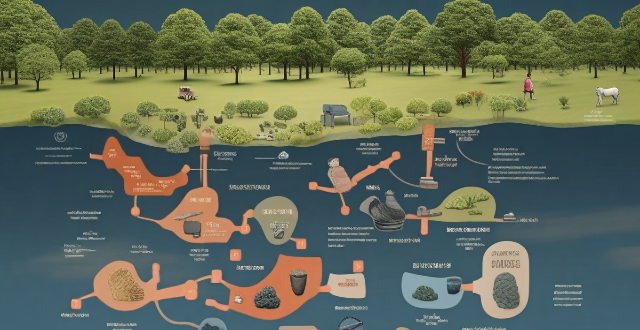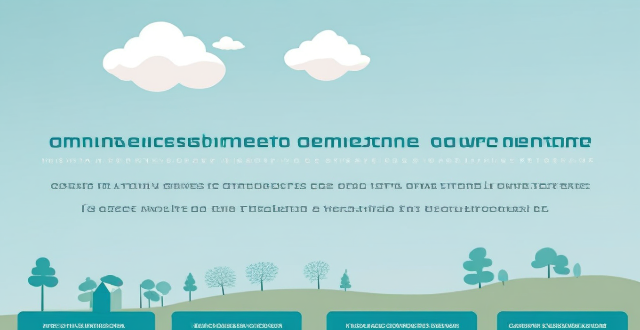Climate Damage

Can we prevent climate loss and damage ?
This topic summary discusses the challenges and potential solutions to preventing climate loss and damage, which are negative impacts of climate change on natural and human systems. It highlights the scientific consensus on climate change, irreversible changes already underway, and differential impacts on various regions and communities. The summary then explores mitigation efforts such as reducing greenhouse gas emissions through energy transition, efficiency improvements, and forestry management, as well as carbon capture and storage technology. It also discusses adaptation strategies like building resilience through infrastructure updates, agricultural practices, coastal protection, community-based adaptation, local knowledge, and capacity building. International cooperation is emphasized through global agreements, financial support, and technology transfer. Lastly, individual actions such as lifestyle changes, advocacy, education, and awareness are mentioned as crucial components in minimizing further damage caused by climate change.

How can we measure the extent of climate loss and damage ?
Measuring the extent of climate loss and damage requires a comprehensive approach that considers various factors, including direct and indirect impacts on natural and human systems. To measure these impacts, we need to identify affected areas, quantify economic losses, assess social and health impacts, evaluate environmental impacts, and consider long-term implications. By doing so, we can better understand the scope of climate loss and damage and develop effective strategies for adaptation and mitigation.

How does climate loss and damage affect vulnerable communities ?
The text discusses the impact of climate loss and damage on vulnerable communities. It highlights that these impacts are multifaceted and can be categorized into various sectors including health, agriculture, infrastructure, and social stability. The health impact includes direct and indirect risks from extreme weather events and disruptions to food and water security. The agricultural impact involves crop failures due to changes in precipitation and temperature patterns, leading to loss of livelihoods and increased food prices. Soil degradation also reduces land productivity. Infrastructure damage includes coastal erosion and inland flooding, causing property loss, disruption of services, and repair costs. Social stability is affected by displacement due to environmental changes and economic strain from adapting to climate change. The conclusion emphasizes that addressing these challenges requires global cooperation and targeted support to build resilience and protect those most at risk.

What are the ethical implications of climate loss and damage ?
The ethical implications of climate loss and damage are multifaceted, involving issues of justice, responsibility, human rights, and intergenerational equity. Those who have contributed the least to climate change are often disproportionately affected by its consequences, raising questions about fairness and justice. Responsibility and accountability for addressing these impacts are also crucial, with industrialized nations having historically emitted more greenhouse gases and generally having more resources to invest in climate action than poorer ones. Climate loss and damage pose serious threats to human rights, including the right to life, health, food, water, and housing. Intergenerational equity is also a significant consideration, as current generations must not deprive future generations of the ability to meet their own needs by depleting natural resources and altering the climate system. Addressing these challenges requires global cooperation and a commitment to creating a more equitable and sustainable world for all current and future inhabitants of our planet.

What is climate loss and damage ?
Climate loss and damage refer to the negative impacts of climate change on natural and human systems, including direct impacts such as extreme weather events and sea-level rise, and indirect impacts such as ecosystem changes and food security issues. Mitigating these impacts involves reducing greenhouse gas emissions and adapting to the inevitable effects of climate change.

What are the benefits of climate resilience ?
Climate resilience is crucial for adapting to climate change impacts and recovering from related damages. It offers economic, social, environmental, political, and cultural benefits. These include reduced damage costs, protection of assets, enhanced productivity, improved public health, community cohesion, continuous education, biodiversity conservation, resource stewardship, reduction of greenhouse gas emissions, increased government legitimacy, international leadership, policy innovation, preservation of heritage, strengthening of cultural practices, and promotion of cultural exchange. Building climate resilience ensures more robust, equitable, and sustainable futures.

What are the long-term consequences of climate loss and damage ?
The article discusses the long-term consequences of climate loss and damage, including rising sea levels, extreme weather events, loss of biodiversity, impact on agriculture, disruption of industries, costs of mitigation and adaptation, health risks, displacement and migration, and impact on culture and heritage. It highlights the need for a global effort to reduce greenhouse gas emissions and adapt to the changing climate in order to create a more sustainable future.

What is the relationship between climate loss and damage and food security ?
The article discusses the complex relationship between climate loss and damage and food security, highlighting how extreme weather events and slower changes in climate can impact food production. It details the consequences of these impacts for food security, such as reduced crop yields, increased prices, loss of livelihoods, nutritional impacts, and displacement. The article also suggests mitigation and adaptation strategies to address this issue, including reducing greenhouse gas emissions, sustainable agriculture practices, crop diversification, improved irrigation systems, early warning systems, and research and development. The conclusion emphasizes the need for collective action to ensure food security in the face of climate change.

What role do governments play in addressing climate loss and damage ?
Governments play a critical role in addressing climate loss and damage through legislation and policy making, research and development, education and awareness, and international cooperation. They can enact laws that regulate emissions and protect natural resources, develop policies that encourage sustainable practices, fund research into new technologies for reducing greenhouse gas emissions, launch public education campaigns to raise awareness about climate change, and work together through international agreements and collaborative projects to share knowledge and resources. By taking these actions, governments can help mitigate the effects of climate change and protect our planet for future generations.

What is the Paris Agreement and its impact on climate governance ?
The Paris Agreement, adopted in 2015, aims to limit global warming and represents a unified effort by countries worldwide to address climate change. Key features include long-term goals, nationally determined contributions (NDCs), adaptation measures, loss and damage mechanisms, financial support, and transparency frameworks. The agreement has impacted climate governance by promoting global cooperation, enhancing political commitment, providing flexibility in NDCs, establishing financial mechanisms, ensuring transparency, recognizing loss and damage, integrating policies, involving the private sector, and raising public awareness. Despite implementation challenges, the Paris Agreement has set the stage for concerted action on climate change.

How does climate change cause losses and damages ?
Climate change causes losses and damages in various ways, including environmental impacts such as extreme weather events, sea level rise, and biodiversity loss; societal impacts such as health risks, food security issues, and water scarcity; and economic impacts such as infrastructure damage, increased insurance costs, and labor market disruptions. Addressing these challenges requires coordinated efforts to mitigate greenhouse gas emissions and adapt to the changing climate.

What are the legal implications of failing to meet climate targets set by international agreements ?
Failing to meet climate targets set by international agreements can have significant legal implications, including liability for damages caused by climate change, violation of international law, and domestic legal consequences. These implications can vary depending on the specific agreement and jurisdiction in question, but some common consequences include public and private claims for damages, trade sanctions, loss of funding or aid, international dispute resolution, regulatory compliance, shareholder pressure, and reputational risk.

What are the economic impacts of climate loss and damage ?
The article discusses the economic impacts of climate loss and damage, including direct impacts on agriculture, coastal communities, and health, as well as indirect impacts on the energy sector, insurance and financial services, and the labor market. It highlights the need for a comprehensive approach to address these challenges.

How can businesses contribute to reducing climate loss and damage ?
Businesses have a crucial role in mitigating climate loss and damage. Here's how they can contribute significantly: 1. **Adopting Sustainable Practices** - Reducing Energy Consumption - Waste Management - Water Conservation 2. **Investing in Clean Technology** - Research and Development - Green Infrastructure 3. **Promoting Sustainable Supply Chains** - Eco-friendly Sourcing - Partnership with Green Companies 4. **Supporting Environmental Initiatives** - Sponsoring Clean Projects - Education and Awareness 5. **Engaging in Carbon Offsetting** - Carbon Credits - Reforestation Projects 6. **Advocating for Policy Changes** - Lobbying for Green Policies - Collaborating with Governments 7. **Developing Circular Economy Models** - Zero Waste - Reusable Products

How can I prepare my home for an earthquake to minimize damage ?
Earthquakes are natural disasters that can cause significant damage to homes and properties. However, there are several steps you can take to prepare your home for an earthquake and minimize the potential damage. Some tips include securing large appliances and furniture, reinforcing your home's structure, securing plumbing and gas lines, and preparing for aftershocks. By following these tips, you can help minimize the damage caused by an earthquake and protect yourself and your family.

What are the most effective strategies for reducing climate loss and damage ?
This article outlines key strategies for reducing climate loss and damage, including transitioning to renewable energy sources, improving energy efficiency, promoting afforestation and reforestation, adopting sustainable agriculture practices, reducing waste and increasing recycling efforts, exploring carbon capture and storage technologies, and fostering international cooperation and policy initiatives.

Can I use homemade cleaners on electronic devices, or will they cause damage ?
Homemade cleaners are cost-effective and environmentally friendly, but using them on electronic devices can be risky. Some homemade cleaners, like vinegar and lemon juice, are acidic and can damage sensitive parts of electronic devices. Others, like baking soda, are abrasive and can scratch surfaces or leave a residue behind. Commercial cleaners, on the other hand, are specifically designed for electronic devices and are tested for safety. Therefore, it is recommended to use commercial cleaners on electronic devices to ensure their safety and longevity.

How might climate-induced natural disasters, such as droughts and floods, impact global food distribution ?
Climate-induced natural disasters significantly impact global food distribution by causing crop failures, livestock losses, and infrastructure damage. Droughts and floods reduce water availability for crops or wash away topsoil, leading to reduced yields or complete crop failures. Examples include wheat, corn, and rice production disruptions in major producing regions. Floods and droughts also lead to the loss of livestock like cattle, poultry, and sheep, affecting meat, dairy, and egg supplies. Infrastructure damage such as roads, bridges, ports, and storage facilities disrupts the supply chain, making it difficult to transport and store food. Understanding these impacts is crucial for preparing and mitigating their effects on food systems.

How does the Paris Climate Agreement address climate justice ?
The Paris Climate Agreement, adopted in 2015, emphasizes climate justice and the need for all countries to take action to limit global warming. It recognizes the unequal impacts of climate change on vulnerable communities and developing countries, and provides mechanisms for financial support, capacity building, and loss and damage compensation. The agreement aims to create a more equitable and just response to the global challenge of climate change.

What are the economic implications of climate disasters ?
Climate disasters have significant economic implications, including direct costs such as infrastructure damage and agricultural losses, indirect costs like lost productivity and investment uncertainty, and global impacts on trade and commodity prices. Addressing climate change is crucial for protecting the economy and ensuring sustainable development.

How do climate change negotiations tackle the issue of climate justice ?
Climate change negotiations address the issue of climate justice by recognizing the disproportionate impacts on vulnerable populations, promoting equitable access to resources and technologies, adhering to the principle of common but differentiated responsibilities, ensuring inclusivity in negotiation processes, addressing loss and damage, promoting sustainable development, setting long-term goals and ambitions, and maintaining accountability. These efforts aim to create a more equitable and resilient global response to the challenges posed by climate change.

How do climate disasters affect human populations ?
Climate disasters, such as hurricanes and floods, have significant impacts on human populations, including loss of life, injuries, damage to property, displacement, and food insecurity. Indirect effects include economic disruption, mental health issues, environmental degradation, social disruption, migration crises, and political instability. Mitigating these effects requires preparedness, response, and recovery efforts, including early warning systems, emergency plans, resilient infrastructure, community education, and climate change mitigation.

What is a climate refugee ?
Climate refugees are individuals who must relocate due to environmental changes from climate change, such as sea-level rise and extreme weather events. This displacement affects social structures, economies, and cultures, and there is a need for international cooperation and sustainable practices to address the issue. There is currently no specific legal status for climate refugees under international law.

What is the role of global warming in climate disasters ?
The article discusses the significant role of global warming in climate disasters, highlighting its impacts on extreme weather events, sea level rise, ecosystems, and food security. It emphasizes the importance of taking action to mitigate these effects through strategies such as reducing greenhouse gas emissions, adapting to changing climate conditions, supporting research and innovation, and encouraging international cooperation.

What are the potential consequences of ignoring climate change ?
The text discusses the potential consequences of ignoring climate change, including environmental effects such as extreme weather events and loss of biodiversity, economic disruptions like damage to agriculture and infrastructure, public health issues including the spread of diseases and heat-related illnesses, and social impacts such as forced migration and reduced quality of life. It emphasizes the importance of addressing climate change to avoid these catastrophic implications for our planet and all life on it.

What are the potential economic benefits of investing in climate adaptation ?
Investing in climate adaptation can bring about several potential economic benefits, including reduced costs of disaster response and recovery, increased resilience of infrastructure and assets, enhanced productivity and efficiency, new business opportunities, and improved health outcomes. These benefits make it an essential component of any comprehensive strategy for addressing climate change and its impacts on our economy and society.

What are the risks associated with climate financing ?
Climate financing is vital for mitigating climate change but comes with economic, policy, environmental, social, reputational, and technical risks that must be managed through strong governance and legal frameworks to ensure effectiveness and credibility.

What is the future of Climate-Smart Technology ?
The future of climate-smart technology is expected to be transformative, offering numerous ways to mitigate climate change and adapt to its effects. Key areas of development include renewable energy, energy efficiency, carbon capture and storage, water management, and agriculture. Emerging technologies such as artificial intelligence, blockchain, and the Internet of Things also have significant potential in this field. However, challenges such as cost, infrastructure, regulation, and public acceptance must be addressed to ensure widespread adoption and effectiveness.

What are the potential impacts of climate conflicts on global security ?
Climate conflicts have the potential to significantly impact global security by causing economic disruption, political instability, and even armed conflict. Governments and international organizations must recognize this issue and take action to mitigate the effects of climate change.

What is the Paris Agreement and how does it contribute to global climate governance ?
The Paris Agreement, adopted in 2015, is a landmark global climate change agreement aimed at limiting global warming to below 2°C and pursuing efforts to limit it to 1.5°C above pre-industrial levels. It contributes significantly to global climate governance by establishing mechanisms such as Nationally Determined Contributions (NDCs), enhancing transparency and accountability, providing finance and capacity building, addressing loss and damage, conducting global stocktakes, and setting long-term goals. These measures help track progress, hold countries accountable for their commitments, support vulnerable nations, assess collective progress, and encourage more aggressive action towards mitigating climate change.